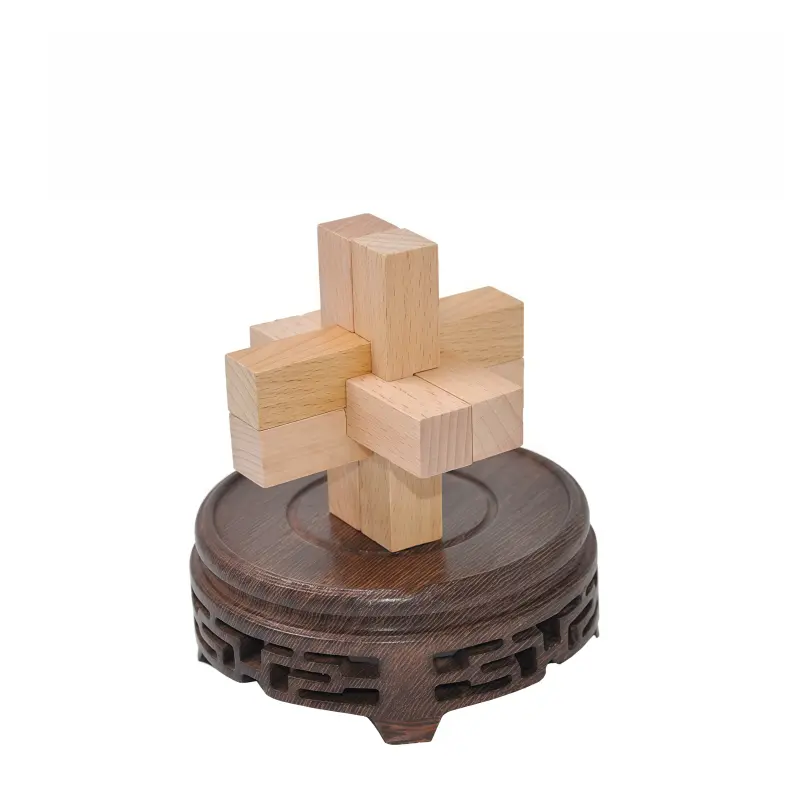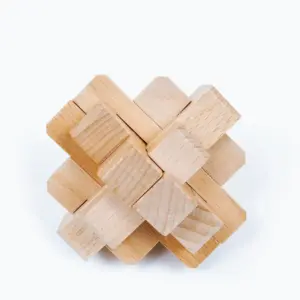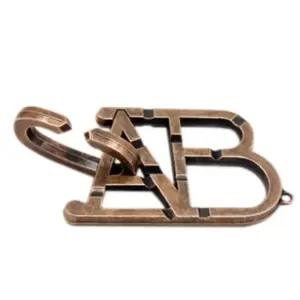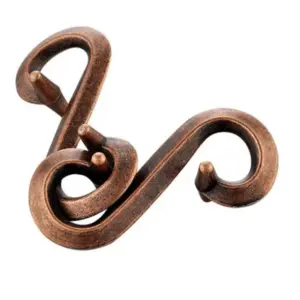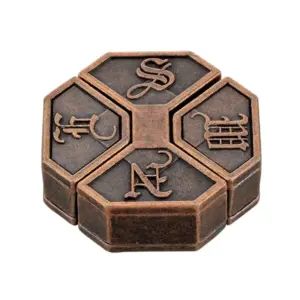If you’ve ever held a six-piece burr puzzle in your hands and thought, “How hard could this be?”—well, you’re about to join a very humbled club. I’ve been collecting and solving wooden puzzles for over fifteen years, and I can tell you with absolute certainty: this deceptively simple-looking cube has brought more grown adults to their knees than any Rubik’s Cube ever did.
Let me walk you through everything you need to know about this fascinating brain teaser, from its rich history to the exact step-by-step solution that’ll save you hours of frustration.
What Exactly Is a Six-Piece Burr Puzzle?
The six-piece burr puzzle, also known as the Chinese interlocking lock or Luban lock, consists of six notched wooden sticks that interlock in one specific configuration. No glue. No hardware. Just pure geometric genius that’s been messing with people’s heads since ancient China.
Here’s what makes it brilliant: taking it apart is laughably easy. Any kid can twist the key piece and watch the whole thing collapse. But reassembly? That’s where the real puzzle begins. It’s like watching a building implode versus trying to rebuild it with your eyes closed.
Six-Piece Burr
- Six-Piece Interlocking Design: Each wooden piece plays a vital role—no excess, no shortcuts. Like the Daoist principle of walking the smooth path, this puzzle rewards those who seek understanding over force, balance over brute strength.
- Mindful Challenge for All Ages: A screen-free brain teaser that teaches patience and precision. In a world of flashy distractions, this burr puzzle whispers timeless wisdom: true mastery lives in simplicity, and real wealth is measured in clarity, not clutter.
Each of the six pieces has a unique profile—some with grooves carved into them, others with protruding blocks. When assembled correctly, they form a perfectly symmetrical cross-shaped structure that feels solid as a rock. Get one piece wrong, and the whole thing refuses to lock.
The Six Pieces: Anatomy of the Lock
Let me break down what you’re actually working with here. I’m going to call these pieces A through F (because calling them “the one with the weird bump” gets confusing fast):
Piece A – The Center Cross:
This is your foundation piece. It’s got two protruding blocks on opposite sides, right at the center, making it look like an H-beam. This piece forms the structural core when you’re assembling, and honestly, if you don’t start with this one positioned correctly, you’re cooked.
Piece B – The Single Groove Piece:
One side has a U-shaped groove (this is where your key piece will sit), and the other side has a small protruding block. The groove orientation matters more than you think—trust me on this.
Piece C – The Double Groove Piece:
This one’s tricky. It has U-shaped grooves on both sides, but they’re offset from each other. This piece comes into play during the final locking phase, and it’s usually where people realize they’ve messed up ten steps earlier.
Piece D – The Key:
The star of the show. This piece has an L-shaped protrusion on one end, and it’s the only piece that rotates to lock and unlock the entire structure. If you can’t find which piece is the key, just wiggle each one—it’ll be the only one that has rotational freedom when the puzzle is assembled.
Piece E – The Symmetrical T-Piece:
Two protruding blocks on opposite sides, perfectly aligned. This creates a T-shape when viewed from the side, and it slides into the structure vertically.
Piece F – The Asymmetrical Piece:
One small block on one side, a larger T-shaped protrusion on the other. This is your final puzzle piece—literally. It fills the last gap and gets locked in when you rotate the key.
How to Take It Apart (The Easy Part)
Before we get to the real challenge, let’s cover disassembly. You need to know this because, well, you’re going to need to take it apart multiple times while learning to reassemble it.
Step 1: Find the key piece. Gently twist each stick until you find the one that rotates slightly. That’s Piece D.
Step 2: Rotate the key piece upward 180 degrees (half a turn). You’ll feel the structure loosen immediately.
Step 3: Pull pieces apart. Once that key turns, the whole thing basically falls apart. Usually the key comes out first, then everything else follows.
See? Easy. My seven-year-old nephew can do this part. It’s what comes next that separates the puzzle enthusiasts from the puzzle survivors.
How to Assemble the Six-Piece Burr Puzzle
Alright, here’s where I’m going to save you hours of table-flipping frustration. I’ve assembled this puzzle hundreds of times, taught workshops on it, and I’ve seen every possible mistake. Follow these steps exactly, and you’ll get it on your first try.
Visual learners: I highly recommend watching [this assembly tutorial on YouTube]
alongside these written instructions. Seeing the pieces move in 3D makes a huge difference.
Assembly Step-by-Step:
Prep Phase:
Lay all six pieces flat on a table. Get familiar with which piece is which. Seriously, take thirty seconds to identify your key piece now—it’ll save you later.
Step 1 – Build Your Foundation:
Take Piece A (center cross) and Piece B (single groove). Cross them perpendicularly, like you’re making a plus sign. Here’s the critical part: Piece B’s groove must face to the right. This isn’t arbitrary—if it faces left, your key won’t have clearance to rotate later, and you’ll be stuck with a half-assembled puzzle.
Step 2 – Insert the Key:
Take Piece D (the key) and slide its L-shaped protrusion into the groove on Piece B. The key should sit comfortably and have rotational freedom. If it’s binding or feels forced, your Piece B orientation is wrong. Go back to Step 1.
Step 3 – First Vertical Piece:
Grab Piece E (symmetrical T-piece) and insert it vertically into the structure. You’ll need to align the protruding blocks with the existing grooves and spaces. It should slide in smoothly and feel stable.
Step 4 – The Horizontal Lock Piece:
Now take Piece C (double groove) and slide it horizontally through the structure. This piece simultaneously locks Piece E and the key piece in place. If it won’t go in, check that Piece E is fully seated and that the key hasn’t rotated out of position.
Step 5 – Final Vertical Piece:
Insert Piece F (asymmetrical piece) vertically into the remaining gap. At this point, the structure should look complete, but it’s not actually locked yet. The key piece should still be able to rotate freely.
Step 6 – The Final Lock:
Here’s the magic moment. Rotate the key piece downward 180 degrees (opposite of how you unlocked it). You’ll feel everything click into place. The structure should now be completely rigid—no wiggle, no give. If it still feels loose, one of your earlier pieces is misaligned.
Congratulations. You’ve just solved a puzzle that’s stumped people for centuries.
Why Is This Puzzle So Difficult?
The six-piece burr puzzle is what I call a “perfectly evil” design. It looks simple. It has only six pieces. The mechanics are pure geometry—no hidden tricks, no optical illusions. And yet, it’s fiendishly difficult.
Here’s why:
1. The sequence matters absolutely. You can’t just throw pieces together. Each piece depends on the previous ones being correctly positioned.
2. Orientation is everything. A piece facing the wrong direction might fit temporarily but will block later steps. You won’t know you messed up until three steps later.
3. The key piece is deceptive. Beginners often don’t realize which piece is the key, or they forget to check if it can rotate freely before continuing.
4. There’s minimal feedback. Unlike a jigsaw puzzle where wrong pieces obviously don’t fit, burr puzzle pieces can seem to fit even when they’re wrong.
I’ve watched puzzle veterans with decades of experience struggle with this one. It humbles everyone eventually.
The History and Philosophy Behind the Design
The six-piece burr puzzle traces its roots back to ancient China, where it was known as the Luban lock, named after Lu Ban, a legendary carpenter and engineer from the 5th century BC. Lu Ban is basically the patron saint of Chinese woodworking—think of him as the da Vinci of ancient construction.
These puzzles weren’t just toys. They were teaching tools used to train apprentice carpenters in precision, spatial reasoning, and patience. There’s a Daoist philosophy baked into the design: the straightest path requires no force, only understanding.
In classical Chinese texts, there’s a passage that roughly translates to: “The great Way is smooth and easy, yet people love shortcuts.” The text criticizes officials who hoarded wealth, wore fancy clothes, and carried sharp swords while granaries sat empty and fields went unplowed—a path that led to ruin, not wisdom.
The burr puzzle embodies the opposite principle. You can’t brute-force it. You can’t take shortcuts. You must understand each piece’s role, respect the sequence, and trust the process. It’s meditation disguised as play.
This philosophy resonates across cultures. Medieval European guilds used similar logic puzzles to test apprentices. The message was universal: mastery comes through patience, not power.
Common Mistakes (And How to Avoid Them)
After teaching dozens of people to solve this puzzle, I’ve seen these mistakes again and again:
Mistake 1: Wrong Key Orientation
If the key piece’s opening doesn’t face the right direction, it can’t complete its final rotation. Always check rotational clearance before proceeding.
Mistake 2: Forcing Pieces
If a piece requires force, it’s wrong. This puzzle relies on precision—pieces should slide smoothly when correctly positioned.
Mistake 3: Skipping the Foundation Check
If Pieces A and B aren’t perfectly crossed at the start, everything downstream will be misaligned. Spend an extra five seconds getting this right.
Mistake 4: Losing Track of Which Piece Is Which
All those wooden sticks start looking similar after a while. Keep them organized, or better yet, mark them temporarily with tape if you’re learning.
Why Every Puzzle Enthusiast Should Own One
I genuinely believe every serious puzzle collector needs a six-piece burr puzzle in their arsenal. Here’s why:
It’s tactile. In our screen-dominated world, there’s something deeply satisfying about working with physical objects. The wood feels good in your hands, the pieces make satisfying clicks when they lock.
It’s replayable. Unlike a jigsaw puzzle you solve once, this one can be taken apart and reassembled infinitely. I still take mine apart occasionally just to keep sharp.
It’s a conversation starter. Leave it on your desk and watch colleagues try (and fail) to solve it. I’ve sparked more interesting conversations with this puzzle than any icebreaker question ever could.
It teaches patience. In an age of instant gratification, spending twenty minutes assembling six wooden sticks is oddly therapeutic.
It’s a perfect gift. For puzzle lovers, engineers, architects, or anyone who appreciates elegant design, this hits differently than another Amazon gift card.
Where the Six-Piece Burr Puzzle Fits in Puzzle History
The burr family of puzzles is huge. There are three-piece burrs, twelve-piece burrs, even 24-piece monsters that take hours to solve. The six-piece version occupies a sweet spot: complex enough to be genuinely challenging, simple enough to master with practice.
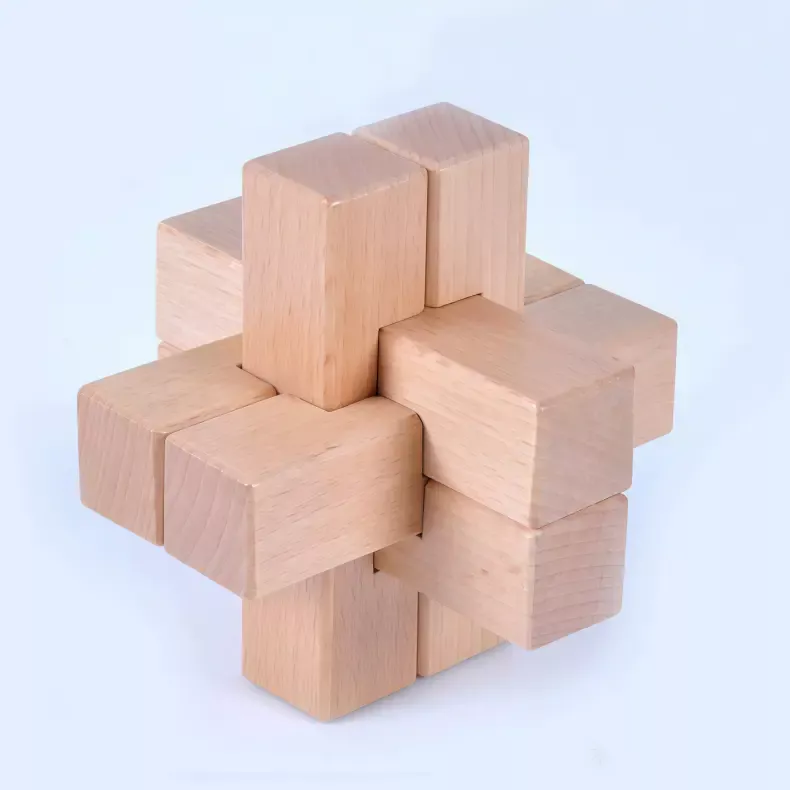
Puzzle historians consider the burr puzzle one of the foundational designs in mechanical puzzles. It influenced countless other interlocking puzzles, from modern wire puzzles to complex disentanglement challenges.
What makes the six-piece version special is its accessibility. You don’t need to be a genius or a mathematician. You just need patience and the willingness to learn from failure. It’s democratic difficulty—anyone can master it, but nobody gets it for free.
Final Thoughts: Is the Six-Piece Burr Puzzle Worth Your Time?
Look, I’m not going to tell you this puzzle will change your life. But I will say this: in fifteen years of collecting puzzles, very few have given me the same satisfaction as the first time I successfully reassembled a six-piece burr puzzle without instructions.
It’s a puzzle that rewards persistence. The kind where you’ll fail five times, get frustrated, walk away, come back, and suddenly—click—everything makes sense. That moment when all six pieces lock into place and you realize you’ve just solved something that’s been stumping people for literally thousands of years? That’s a feeling worth chasing.
Whether you’re a puzzle veteran looking for your next challenge, a woodworking enthusiast who appreciates craftsmanship, or someone searching for a screen-free way to unwind, the six-piece burr puzzle delivers.
Just remember: the great Way is smooth and easy. Don’t force it. Understand it. Respect the process.
And when you finally get it? You’ll know exactly why this simple wooden puzzle has survived centuries while empires rose and fell around it.
Now go forth and solve. And maybe keep the assembly instructions bookmarked—you’ll probably need them again.


